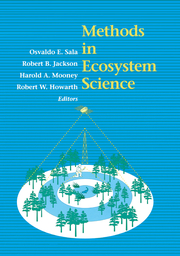-
Zusatztext
-
Ecology at the ecosystem level has both necessitated and benefited from new methods and technologies as well as those adapted from other disciplines. With the ascendancy of ecosystem science and management, the need has arisen for a comprehensive treatment of techniques used in this rapidly-growing field. Methods in Ecosystem Science answers that need by synthesizing the advantages, disadvantages and tradeoffs associated with the most commonly used techniques in both aquatic and terrestrial research. The book is divided into sections addressing carbon and energy dynamics, nutrient and water dynamics, manipulative ecosystem experiements and tools to synthesize our understanding of ecosystems. Detailed information about various methods will help researchers choose the most appropriate methods for their particular studies. Prominent scientists discuss how tools from a variety of disciplines can be used in ecosystem science at different scales.
-
-
Autorenportrait
- InhaltsangabeMethods in Ecosystem Science: Progress, Tradeoffs, and Limitations.- References.- 1. Carbon and Energy Dynamics.- 1 Stand Structure in Terrestrial Ecosystems.- Methodological Approaches.- Models of Canopy Architecture.- Remote Sensing Instrumentation for Indirect Methods.- Portable Ground Instruments.- Aerial Remote Sensing.- Approaches for Estimating Stand Structure.- Canopy Height.- Vertical Foliar Distribution.- Stand Density.- Cover and Leaf Area.- Biomass.- Three-Dimensional Structure.- References.- 2 Methods of Estimating Aboveground Net Primary Productivity.- Methods to Estimate ANPP in Fast Turnover Ecosystems.- Estimates of Aboveground Biomass.- Methods to Estimate ANPP in Slow Turnover Ecosystems.- Errors Associated with Estimates of ANPP.- Optimal Methodology to Estimate ANPP.- Summary.- References.- 3 Global Terrestrial Gross and Net Primary Productivity from the Earth Observing System.- Theoretical Basis for the Algorithm for Global NPP.- Relating NPP and APAR.- Relating APAR and NDVI.- Biophysical Variability of ?.- Parameterization of ? with Global BIOME-BGC Simulations.- Algorithm Implementation Logic in EOS.- Satellite-Derived Input Variables.- Final NPP Algorithm.- Validation of Global NPP.- Summary.- References.- 4 Methods of Estimating Belowground Net Primary Production.- Concepts.- Methods.- Biomass.- Ingrowth Cores.- Isotopes.- Carbon Balance.- Nitrogen Balance.- Minirhizotrons.- Uncertainty in Estimates of BNPP.- Summary.- References.- 5 The Measurement of Primary Production in Aquatic Ecosystems.- Light and Dark Bottle Oxygen Technique.- Carbon-14 Technique.- Problems and Challenges with Light and Dark Bottle and Carbon-14 Techniques.- In Situ Diel Approaches.- Remote Sensing Techniques.- References.- 6 Benthic Respiration in Aquatic Sediments.- Total Benthic Mineralization, Flux Measurements.- Other Total Mineralization Assays.- Respiratory Pathways, Oxygen Respiration.- Nitrate Reduction.- Manganese and Iron Reduction.- Sulfate Reduction.- Methanogenesis.- Conclusions.- References.- 7 Decomposition and Soil Organic Matter Dynamics.- Plant Litter Decomposition.- Fine Litter Decomposition Rates.- Woody Detritus.- Reciprocal Transplants and Standard Substrates.- Soil Organic Matter Dynamics.- Soil Organic Matter Stores.- Physical Fractionation of Soil Organic Matter.- Biological Soil Organic Matter Fractions.- Use of Tracers.- References.- 8 Stable Isotope Tracers and Mathematical Models in Soil Organic Matter Studies.- Soil Organic Matter Pools and Dynamics.- SOM Pools.- SOM Additions.- SOM Losses.- Internal SOM Transfers.- SOM Transformations.- Stable Carbon Isotopes in Organic Matter.- Well-Mixed One Box Model of C Isotopes in SOM.- Uses of Well-Mixed Box Models in SOM C Studies.- Models for Vertical Variations in the ?13C Value of SOM.- Stable Nitrogen Isotopes in Organic Matter.- Well-Mixed One Box Soil Ecosystem Model of N Isotopes.- Use of N Isotopes in SOM as a Tracer.- Model of Vertical Variations in ?15N Value of SOM.- Conclusions.- References.- 9 Microbial Carbon Cycling in Pelagic Ecosystems: Microbial Methods for Ecosystem Scientists.- Abundance and Biomass.- Epifluorescent Direct Count.- Sample Preservation.- Count by Flow Cytometry.- Active and Inactive Cells.- Cell Size and Biomass.- Growth and Respiration of Planktonic Bacteria.- Bacterial Secondary Production.- Bacterial Respiration.- Uptake and Turnover of Specific Substrates.- Substrates Supporting Bacterial Growth.- Conclusions.- References.- 10 Herbivory in Terrestrial Ecosystems.- Consumption.- Animal-Based Methods.- Plant-Based Methods.- Differential Use of the Two Approaches.- Effect of Herbivores on Primary Production.- Compensatory Growth.- Approaches.- References.- 2. Nutrient and Water Dynamics.- 11 Canopy Fluxes.- The Canopy Scale.- The Surface Boundary Layer.- Net Ecosystem Exchange.- Flux Footprint.- Methodologies.- Aerodynamic Method.- Energy Balance/Bowen Ratio.- Eddy Covariance.- Conditional Sampling.- Errors in Long-Te
Detailansicht
Methods in Ecosystem Science
ISBN/EAN: 9780387987439
Umbreit-Nr.: 1440394
Sprache:
Englisch
Umfang: xxii, 421 S., 6 farbige Illustr., 16 s/w Tab.
Format in cm:
Einband:
kartoniertes Buch
Erschienen am 11.08.2000


